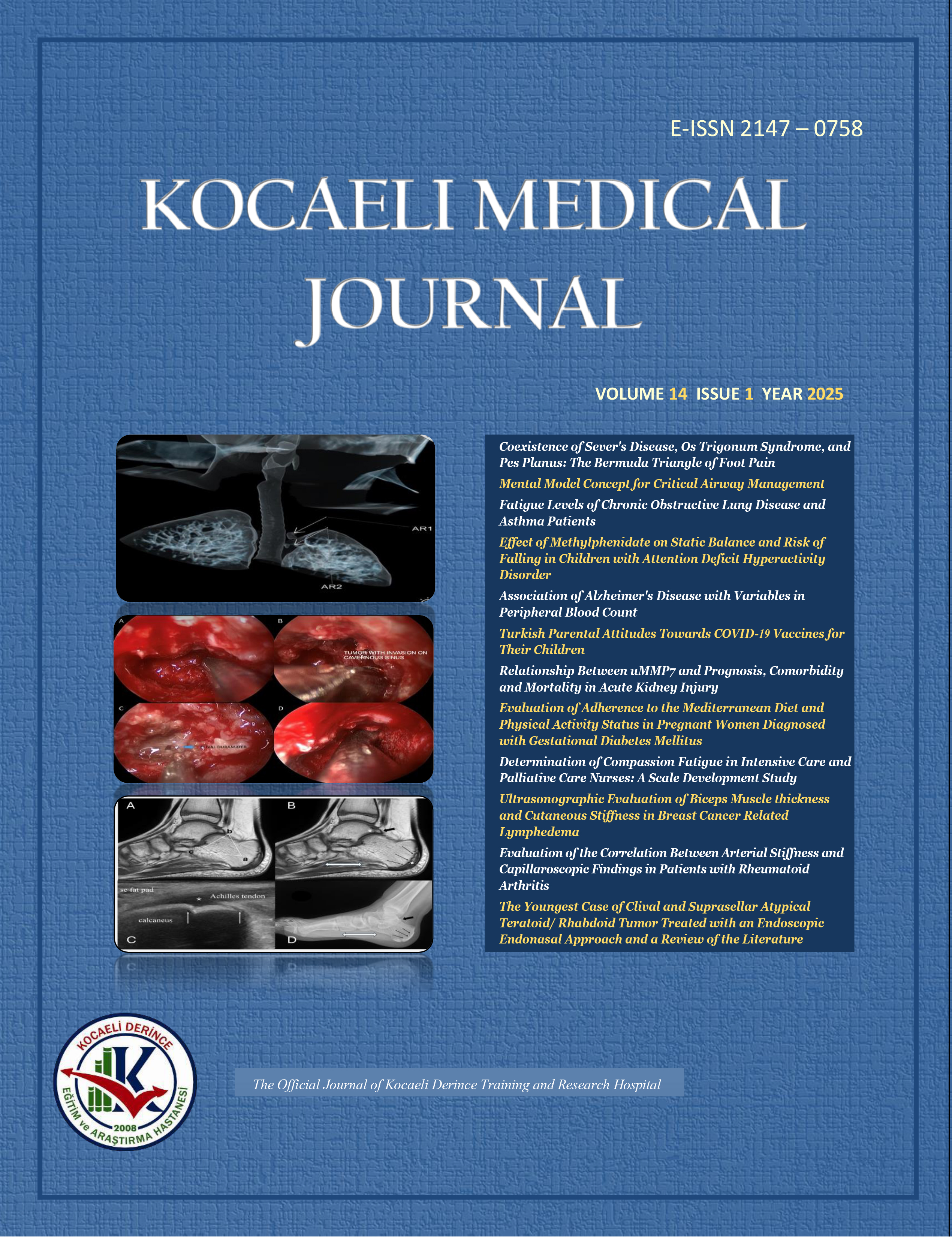
Volume: 5 Issue: 1 - April 2016
| ORIGINAL ARTICLE | |
| 1. | Predictive value of direct radiographic measurements as a marker of severity of valvular regurgitation Tümer Erdem Güler, Tolga Aksu, Veli Kaya, Omaç Tüfekçioğlu Pages 1 - 5 INTRODUCTION: The chest radiography (CR) is widely available and frequently performed as a screening test for cardiac chamber enlargement. In this study, we compared cardiothoracic ratio (CTR), cardiac area (CA) and cardiac volume (CV) on CR and echocardiographic diamaters of left ventricule and severity of valvular regurgitation. METHODS: The studied population consisted of 220 patients (125 female, 95 male) with isolated or combined mitral, aortic and tricuspid regurgitation. All of the patients had near normal cardiac systolic function (Left ventriküler ejection fraction >40%). CR and echocardiographic examination were performed on the same day in every patient. The patients were grouped by the degree of valvular regurgitation as mild, moderate, or severe. RESULTS: In the simple linear pearson correlations test, left ventricular endsystolic diameter correlated better with CV than with CA and CTR. However left ventricular enddiastolic diameter correlated both with CA and CV. The results of the multiple comparison test were evaluated and severity of mitral and tricuspid regurgitation correlated better with CA and CV than with CTR. Whereas severity of aortic regurgitation only correlated with CV. DISCUSSION AND CONCLUSION: CR is a cheaper and easier method as compared to echocardiography and potential usage in routine clinic practice may increase after the present study. |
| 2. | Prevalence of ocular surface disease in glaucoma patients Ruken Çinik, Nurşen Yüksel, Dilara Pirhan Pages 6 - 10 INTRODUCTION: To evaluate the prevalence of ocular surface disease (OSD) in glaucoma patients. METHODS: 173 eyes of 88 patients aged 17 years or older with primary open angle glaucoma (POAG), pseudoexfoliation glaucoma (PEG) and ocular hypertension (OHT) were enrolled in the study. Each patient completed for Ocular Surface Disease Index (OSDI) questionaire, and underwent evaluation by Schirmer test, conjunctival and corneal Lissamine green (LG) dye test and tear break-up time (TBUT). RESULTS: Using the OSDI survey dry eye symptoms were assessed. Symptoms were reported in 137 eyes (79%) and in 68 (39%) severe symptoms were recorded. Schirmer testing showed decreased tear production in 91 eyes (52.6%). Severe tear deficiency was detected in 31 (17.9%) eyes. LG staining showed positive results in117 (67.6%) patients, 6 (3.4%) had severe staining. TBUT demonstrated abnormal tear quality in 146 (84%) patients and severe decrease in tear quality was found in 69 (39.8%) patients. There was a significant difference between OSD symptoms and signs and the use of BAK-containing eyedrops. The results of the LG dye test and OSDI revealed that there was also a correlation with number of the drugs used in addition to the use of BAK-containing drug. DISCUSSION AND CONCLUSION: In the majority of patients with POAG, PEG and OHT symptoms of OSD and/or findings were detected. The combination of OSD and BAK-containing eyedrops use significantly affects the quality of tear in this patient population. |
| 3. | Postoperative Histopathology Findings of Ultrasonographically diagnosed Gallbladder Polyp Adem Yüksel, Murat Coşkun, Hamdi Taner Turgut, Mehmet Özyıldız, Murat Burç Yazıcıoğlu, Selim Yiğit Yıldız Pages 11 - 15 INTRODUCTION: Gallbladder polyps are lesions with risk of malignancy. This risk cannot be determine with ultrasonography (USG) exactly though it is the most commonly used tests in the diagnosis of gallbladder disease. This situation is still a major problem in clinical practice. In this study, we aimed to evaluate the compatibility of characteristics of polyps detected with ultrasonography preoperatively with the histopathological examination findings. METHODS: 55 patients who had a laparoscopic cholecystectomy operation for gallbladder polyps in our clinic, were included in this study. The decision of surgery was given according to polyp size of ≥10 mm, or <10 mm but who has risk factors (solitary or sessile polyps, patients aged ≥ 50 years, accompanying with gallstones or increasing of polyp size during follow-up and symptomatic patients). RESULTS: The mean age of the patients were 48.6 ± 12.2 (24-83) years. The preoperative polyps size were 6.7 ± 2.9 (2-15) mm. Histopathologic examination revealed that no malignancy was observed in any patients and only 5.4% (3/55) of cases had a real polyp. The size of all polyps which were accepted as real polyp, were ≥ 10 mm. DISCUSSION AND CONCLUSION: The most important criteria for surgical treatment decision of gallbladder polyp is the polyp size, must be greater or equal to 10 mm. In patients who has <10 mm polyp, surgical treatment should be advised more selectively to patients who had risk factors. |
| 4. | The efficiency of the sonographically - guided vacuum-assisted biopsy method in small breast lesions with unknown or low malignancy potential Gülten Sezgin, Makbule Varer, Melda Apaydın, Gökhan Duygulu Pages 16 - 20 INTRODUCTION: In recent years, the number of the malpractice cases concerning the cytological misdiagnoses in the small breast lesions has gone up. In this study, we used sonographically-guided vacuum-assisted biopsy (USVAB) method to excise the lesions of 1 cm or smaller in diameter, which have unknown or low malignancy potential. We discussed the efficiency of USVAB in diagnosing and treating such lesions. METHODS: Thirty five lesions with unknown or low malignancy potential were excised with USVAB between February-December 2014. All subjects were followed up by US for a period of 12-18 months. RESULTS: Three subjects, diagnosed by USVAB with malignancy, were referred to the surgery. All USVAB results were correlated with surgical diagnosis and long-term US follow-ups. However, 12 subjects showed residual lesions, which established a high rate (34,3%). DISCUSSION AND CONCLUSION: For the small breast lesions with unknown or low malignancy potential, the USVAB method is superior with its higher diagnostic accuracy, and increases chances to diagnose breast cancer in early stages. However, due to its high residual lesion rates, it is not very effective for therapeutic excision yet. |
| 5. | Retrospective Analysis of Breast Surgery Outcomes ın Males Mehmet Fatih Ekici, Zülfü Bayhan, Sezgin Zeren, Çağrı Tiryaki, Cengiz Koçak Pages 21 - 24 INTRODUCTION: We aimed to present patients who underwent surgery for male breast disease in our clinic. METHODS: 28 male patients who underwent breast surgery between December 2011 and January 2015 were retrospectively evaluated. Patient age, surgical procedure, pathology, laterality, imaging techniques were evaluated. RESULTS: The most frequently performed surgery was subcutaneous mastectomy for gynecomastia. Seven cases had bilateral gynecomastia. 3 patients had breast cancer were diagnosed with invasive ductal carcinoma pathological evaluation. Ultrasonography was used in all patients. Mammography never been applied to a patient. DISCUSSION AND CONCLUSION: Male breast cancer, compared to women, it is more rare. First admission to doctor are usually detected in advanced stage disease. Gynecomastia and male breast mass should be made between the differential diagnosis of cancer. |
| 6. | Using Students Feedback for the Evaluation of Clinical Skills Training Program Arif Onan, Ece Abay, Orhan Odabaşı Pages 25 - 32 INTRODUCTION: The basic medical procedures that a medical student should become competent, and the levels of the competencies have already been defined. The practices in clinical skills laboratories can be safely and effectively conducted. The self-evaluations of the students on their education provide valuable data for program development. Aim: The aim of the study was to evaluate the feedback of the medical students on superficial suturing skills conducted in clinical skills laboratories. The study investigated the feedback of the students in 2012-2013 academic year, the parts that were taken into account, and the similarities and differences in the feedback of the students in the consequent year. METHODS: The Department of Medical Education and Informatics in Hacettepe University Faculty of Medicine achieved appropriate program developments regarding the feedback the students and faculty members. The quantitative and qualitative data gathered from the students feedback forms in the consequent academic years were studied in a descriptive way with supporting and differentiating components. RESULTS: The level of the students feedback became higher for the items, Appropriate repetition of the training, receiving support, and competence which were relatively lower in the first academic year. In general, qualitative data were compatible with quantitative data, with only a few exceptions. DISCUSSION AND CONCLUSION: The program development process was welcomed by the students and it was reflected on the student feedback. The comments about some propositions didnt change, and were still parallel to the former results. The values for reliability and validity of the form revealed that the evaluation form was functional. |
| CASE REPORT | |
| 7. | Post-traumatic Hirayama Disease: Case Report Erdem Özyurt, Uygar Utku, Deniz Tuncel, Mustafa Gökçe Pages 33 - 35 The characteristic clinical features of Hirayama disease are young age at onset, sporadic occurrence, male preponderance, wasting and weakness confined to a single or bilaterally upper limb without involvement of cranial nerves, pyramidal tracts, sensory, cerebellar or extrapyramidal systems. A 22-year-old girl was presented with slowly progressive weakness of her upper limbs especially on her right side like a lower motor neuron syndrome. She had a car accident one year ago. She had a complaint of weakness on her left side for last six months. No intervertebral disc herniation was present, but there was an evidence of old traumatic injury. Here, we presented a rare case of Hirayama disease after a trauma. |
| 8. | Laringospazm Sonrası Gelişen Negatif Basınçlı Akciğer ödemi Negative pressure pulmonary edema following laryngospasm Sarpel Gürbüz, Canan Balcı, Ayşenur Ay, Öztürk Taşkın, Gözde Çelik, Hazel YağcızeybekPages 36 - 39 |
| 9. | Ancient schwannoma in the groin: A Case report Emre Can Polat, Levent Özcan, Bülent Katı, Cevper Ersöz, Alper Ötünçtemur Pages 40 - 42 Schwannomas are tumors that originate from Schwann cells and which may occur in any region of the body. In spite of the rich innervation of the genital area, these kinds of tumors are not common in the scrotum. A 25 year old man presented history of painless scrotal swelling. Scrotal ultrasonography revealed inguinal mass. Surgical excision was undertaken and histology was an ancient schwannoma. We report ancient schwannoma of the groin with a review of the literature. |
| 10. | Ulcerative Plaque in the Innominate Artery Which is Diagnosed During the Coronary Bypass Operation Rezan Aksoy, Hakan Parlar, Çağrı Düzyol, Özgür Barış, Atike Tekeli Kunt, Cevdet Uğur Koçoğulları Pages 43 - 45 Atherosclerotic plaques in the ascending aorta can cause ischemic strokes and rupture. Ulcerated plaques in the innominate artery is a rare condition. In this case report we described that the patient which has ulcerated plaques in the innominate artery which was observed it during the coronary bypass operation. In this paper is presented 71 year old male patient. Coronary bypass operation was decided as a result of coronary angiography. Ulcerated plaques were observed at the beginning of ınnominate artery during the exploration in the surgery. Aorta coronary bypass graft was done with cardiovasculary bypass under general anesthesia. The innominate artery with ulcerated plaque, was repaired with teflon felt to prevent postoperative rupture and dissection. He was discharged in the postoperative six days. The cerebrovascular and cardiovascular events were not observed during one year follow up. In this article, during the coronary artery bypass grafting surgery a rare ulcerated plaque in the innominate artery, we aimed to discuss surgical methods with in literature. |
| 11. | Nadir bir masif asit nedeni: Periton Tüberkuloz olgusu Göktuğ Şirin, Zeynep Öztürk, Züleyha Akkan Çetinkaya, Mesut SezikliPages 46 - 48 |
| 12. | Primary Sjögren's Syndrome Presenting with Hypokalemic Paralysis due to Distal Renal Tubular Acidosis: A Case Report Didem Eroğlu, Erkan Şengül, Fulya Dörtbaş, Esra Yeşilyurt, Emre Dönmez Pages 49 - 52 Sjögren's syndrome is characterized by lymphocytic infiltration of exocrine glands is a chronic autoimmune disease often arises with mouth and eye dryness complaints. Renal involvement in Sjögren's syndrome is not rare. Sjögren's syndrome often cause tubulointerstitial nephritis and distal renal tubular acidosis. Hypokalemia is the most common electrolyte disorder in patients with distal tubular acidosis. The etiology in patients with hypokalemia, paralysis and distal renal tubule acidosis should be considered Sjögren's syndrome. |
| 13. | Sublingual Dermoid Cyst with Cervical Extention Selahattin Genç, Ahmet Demir, Ahmet Tuğrul Eruyar, Adin Selçuk Pages 53 - 55 Dermoid cysts of the floor of the mouth are rare, although they may involve any area in the midline of the neck. By determining the correct extension of the cyst through the neck prior to surgery, total excision by intraoral or transcervical approach will provide adequate management. However, inadequate intraoral excision of the mass that exceeds mylohyoid muscle and extends through neck will result in recurrence. In this article, we wanted to remind the sublingual dermoid cysts with a case having previous intraoral insufficient excision and, therefore, recurrent mass excised via transcervical approach. |
| 14. | Pulmonary Brucellosis Case Report Selçuk Nazik, Süheyla Kömür, Aslıhan Ulu, Taylan Bozok, Behice Kurtaran, Ayşe Seza İnal, Yeşim Taşova, Hasan Salih Zeki Aksu Pages 56 - 59 Brucellosis, an endemic disease in our country, is a systemic disorder characterized with recurrent fever, joint pain, malaise and anorexia. Although it may affect many systems, respiratory involvement is quite rare. In case of respiratory system involvement, the most common (10-33%) symptom is non-productive cough. Our patient was a 76 year old male living in rural areas engaged in farming. He was hospitalized with fifteen days ongoing complaints, dry cough, fever with chills and tendency to sleep. On physical examination, fever, tachypnea, decreased breath sounds at left lung baseline and crepitan crackles at right baseline and loss of muscle strength was present. In his history, fresh cheese consumption was present. Empirically, ceftriaxone and clindamycin was initiated. Brucella agglutination was 1/160 titer positive. Doxycycline and rifampin was started. Thoracic computed tomography revealed pneumonia and minimal pleural effusion on the left lobe. The other pneumonia agents were excluded serologically. Cerebrospinal fluid revealed normal findings. Neurobrucellosis was excluded. On the fifth day of brucellosis treatment patient was afebrile, general condition improved and lung symptomsand findings resolved. Blood culture was positive for Brucella melitensis. The patient completed 8 weeks of treatment, clinical and radiological improvement was seen. Brucellosis, an endemic disease in our country, rarely shows pulmonary involvement and it should be kept in mind in differential diagnosis in patients admitted with pneumonia. |
| 15. | Recurrent Aortoenteric fistula after aortobifemoral bypass surgery: A Case Report Zülfü Bayhan, Mehmet Fatih Ekici, Sezgin Zeren, Çağrı Tiryaki, Ahmet Aksoy, Mustafa Cem Algın, Şükrü Aydın Düzgün Pages 60 - 63 Aortoenterik fistula (AEF) is a rare disease which may be secondary to aortic reconstructive surgery and conclude with serious complications. AEF, may cause sudden and massive bleeding which may cause sudden death. Although sudden death can be seen often due to hemorrhage, rarely patients can be lost with septic complications. Multisiciplinary approach to AEF patients is very important. In this article, we present multisiciplinary approach in a case of a 72 years old man who underwent surgical treatment twice, because of two aortoenteric fistula following an aortobifemoral bypass operation along with literature |
| 16. | Sağ Sürrenal Kaynaklı Dev Malign Onkositik Tümör Tonguç Utku Yılmaz, Levent Trabzonlu, Gökhan Pösteki, Sertaç Ata Güler, Yeşim Saliha Gürbüz, Erdem OkayPages 64 - 68 |
| REVIEW ARTICLE | |
| 17. | Usage of new oral anticoagulant drugs in clinical practice of neurology Muhammed Nur Öğün, Uygar Utku Pages 69 - 72 It is increased the usage of new oral anticoagulant drugs currently. Our aim is to increase the level of knowledge about these drugs and to ensure the safety usage in daily clinical practice. |












